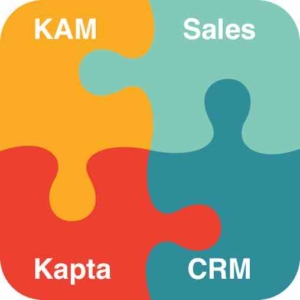CRM and Kapta: Making the Most of Both Platforms
in CRM, Customer Engagement /Many of our customers use Salesforce and/or other CRM tools for generating new leads. As a result, we often hear the question: “Why Kapta? Why not just keep using my CRM?” We also see the corresponding Google search: “Kapta vs. CRM.”
But while it’s useful to compare CRM and Kapta platforms, we don’t actually in terms of “vs” here. We think in terms of “and.” Here’s why: Sales is one function in your organization; Key Account Management is another. They are complementary, but distinct. Therefore, they require complementary, but distinct tools.
In this blog post, we’ll explore:
- How Key Account Management is distinct from sales
- How Kapta is distinct from CRM
- How to use both platforms in harmony
KAM and Sales: Different Roles
Speaking generally, sales is about driving growth by generating new leads and getting new customers. Key Account Management is about driving organic growth by building lasting engagement with existing customers. Both are about driving growth, and on some level, both are about “selling” your products or services to clients. However, the process and tone for each are very different.
In sales, your goal is to get the business. You’ll be asking yourself: Have they heard of you? Do they understand what you offer, why it’s valuable, and why they need you? Do they already work with a competitor? This pitch requires a specific set of messages, skills, and technology.
In Key Account Management, your goal is to keep and grow the business. Your clients have already signed on with you, so they know who you are and why they should invest in your products or services. Now you need to build on the relationship, making yourself indispensable so that as time goes on, your customer not only renews their contract with you, but also increases their scope of work.
KAM and Sales: Different Customers
How do you know which accounts are key accounts? Key accounts are those with particular financial or strategic important to your organization.
The Pareto Principle states that 80% of outcomes are generated by 20% of inputs. Applied to your organization, this means that a significant portion of your revenue comes from a small subset of high-value clients. If that’s not true for you—if every customer is worth more or less the same dollar amount—then Key Account Management is not for you. Stick with sales, and keep working your CRM for more leads.
If you do have a small number of high-value accounts that stand out for not only their current revenue, but also their potential to grow, then you need to approach these accounts differently than you would your other accounts. It doesn’t mean you ignore anyone. You just recognize the importance of certain accounts and allocate internal resources accordingly.
One final note: As you’re identifying Key Accounts in your organization, keep in mind that revenue isn’t the only factor. Sometimes a client isn’t generating a ton of income in the moment, but maybe their mission/vision/offering is a perfect strategic fit for where your own organization wants to go. Or maybe you see some real potential and want to stay on board for the long-term. Either way, think big picture with Key Account Management—it’s about the long game!
KAM and Sales: Different Tech
Part of growing business through Key Account Management is cross- and upselling. So, yes: A Key Account Manager is in some respects a salesperson. However, as a Key Account Manager, you should know your customers inside and out: What they’re trying to accomplish, what stands in their way, what they struggle with, and how you can help. The sales tone shifts as a result: You are offering an effective solution to a problem your client is facing vs attempting to sell them something.
In order to earn that kind of trust, Key Account Managers need tools built purposefully to help them do their jobs. While most sales and marketing teams have purpose-built technology supporting and accelerating their efforts, even the most advanced Key Account Managers are often working with a hodge-podge of Excel sheets, emails, CRM data, project management tools, and powerpoint decks on the server somewhere.
KAM and Sales: Different Targets
Here’s a subtle but critical difference between KAM and sales: How you generate internal growth goals. In sales, you might examine the market, the competition, your target customer, your price point, your sales staff capacity—a host of factors that help you determine how much you can reasonably expect to grow in a given quarter or fiscal year.
In KAM, everything goes back to the customer. You start by understanding your customer’s growth goals, and projecting your organic growth goals accordingly. This relies on a couple of key truths: (1) Return customers are more likely than new customers to purchase premium products and services, and (2) If you help someone grow, you essentially help them have more money to spend on you.
So for example, say your customer wants to increase revenue by 30% in the next fiscal year. Your job as a Key Account Manager is to help them achieve that growth so you can reasonably expect them to increase their spending with you to some proportional degree. Your organic growth goal as a Key Account Manager is current revenue + the value of premium add-ons or additional work you think they’ll sign on for once they’re satisfied with your work and enjoying more cash flow as a direct result of your partnership with them.
There’s a second layer of Key Account Management and its role in your organization’s overall financial health. Namely, the cost of losing an important client. Losing a client not only costs your organization the direct revenue from the account, but also the indirect costs of replacing that revenue. The intense pressure not to lose accounts, plus the pressure to grow them incrementally year over year, is something that distinguishes the role of Key Account Managers.
Kapta and CRM: Purpose-Built Tech for Different Teams
CRM is specifically designed to support sales teams as they generate new leads and win new business—and it’s a really effective tool. However, most CRMs lack the focus to “zoom in” on a particular customer or account, effectively tracking strategic goals throughout the entire engagement. That’s where Kapta comes in.
Just as CRM is purpose-built for sales teams, Kapta is purpose-built for Key Account Managers. Kapta supports KAMs as they get to know their clients, develop tailored action plans to help them reach their goals, and measure their success—both with respect to their client’s goals and their own. Kapta tracks what matters most to Key Account Managers: The health, engagement, and activity on a small set of accounts—or even, in some instances, a single account.
Working Together: KAM and Sales, Kapta and CRM

For some organizations, KAM is everything. Advertising agencies, for example, often have a short list of extremely high-dollar clients. In that case, every single account is a key account, and account management function is a well-established, high-functioning role. CRM often isn’t even in the tech stack.
In other organizations, KAM and sales work together. Sales generates new leads, and KAM takes over when one of those leads grows into a Key Account (one with particular strategic or financial importance within the organization). If that’s the case, there is space for both CRM and Kapta; in fact, Kapta syncs seamlessly with CRM to import account history and contact info, as well as automatically share updates between both platforms. This avoids double-entry and creates even more partnership between the sales and Key Account Management teams, maximizing both the new and organic growth approaches in your organization.
Conclusion: You Can Have Both
In general, there’s no need for sales to compete with KAM within an organization; both roles are important. Similarly, there’s no need for Kapta to “compete” with CRM—both tech platforms can serve an organization well.
Here’s a high-level summary of how each platform excels:

For more on optimizing Key Account Management through smart technology, click here. And to learn more about how Kapta supports KAM while integrating fully with your CRM, schedule a personal demo.







